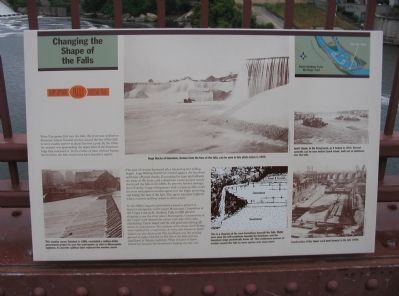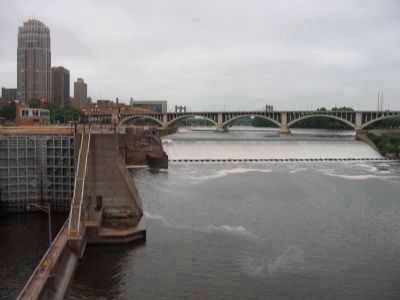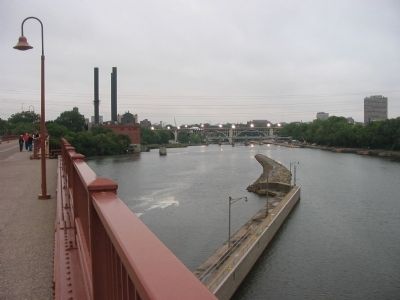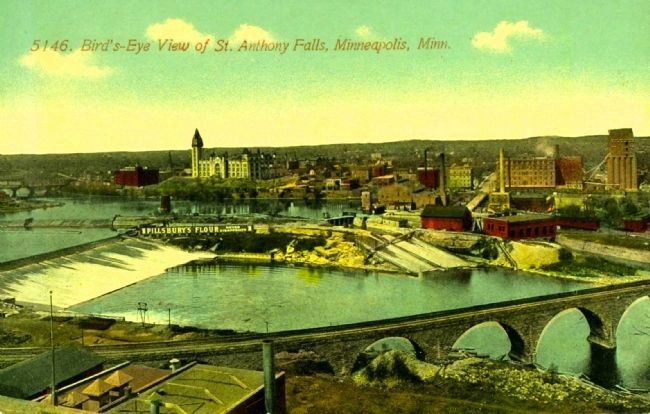Downtown East in Minneapolis in Hennepin County, Minnesota — The American Midwest (Upper Plains)
Changing the Shape of the Falls
— Saint Anthony Falls Heritage Trail —
The pace of erosion increased after lumbering and milling began. Logs floating downriver crashed against the limestone and broke off great chunks. Excavating for dams and tailraces ate away at the stone, and a disastrous tunnel project nearly destroyed the falls in the 1860s. To prevent further damage, the US Army Corps of Engineers built a concrete dike under the river and placed a wooden apron over the ledge, protecting and hiding the face of the falls. The apron was later replaced with a concrete spillway which is still in place.
In the 1930s Congress authorized a massive project to improve navigation on the Upper Mississippi. Completion of the Upper Lock at St. Anthonay Falls in 1963 allowed shipping to use the river above Minneapolis. Construction of the Upper Lock altered the entire west side of the falls, eliminating Upton Island and the mill pond and cutting off access to waterpower. Two sections of the Stone Arch Bridge were replaced by a steel truss. A rocky islet known as Spirit Island was also destroyed. This landmark was the nesting ground of eagles that fed on fish below the falls and was significant in Dakota traditions. What remains of Spirit Island lies beneath the breakwater leading into the lock.
marker photo captions:
This wooden apron, finished in 1880, concluded a million-dollar government project to save the waterpower so vital to Minneapolis business. A concrete spillway later replaced the wooden apron.
Huge blocks of limestone, broken from the face of the falls, can be seen in this photo taken in 1850.
This is a diagram of the rock formations beneath the falls. Water wore away the soft sandstone beneath the limestone, and the limestone ledge periodically broke off. This continuous process of erosion caused the falls to move upriver over many years.
Spirit Island, in the foreground, as it looked in 1855. Several sawmills can be seen behind Spirit Island, built out on platforms over the falls.
Construction of the Upper Lock went forward in the late 1950s.
Erected by the St. Anthony Falls Heritage Board.
Topics. This historical marker is listed in these topic lists: Charity & Public Work • Waterways & Vessels. A significant historical year for this entry is 1963.
Location. 44° 58.829′
N, 93° 15.322′ W. Marker is in Minneapolis, Minnesota, in Hennepin County. It is in Downtown East. Marker can be reached from West River Parkway west of Portland Avenue South. Marker is attached to the north railing of the Stone Arch Bridge. Touch for map. Marker is at or near this postal address: 1 Portland Avenue, Minneapolis MN 55401, United States of America. Touch for directions.
Other nearby markers. At least 8 other markers are within walking distance of this marker. The West Side Milling District (within shouting distance of this marker); Beneath the Surface (within shouting distance of this marker); Stone Arch Bridge - Great Northern Railway (within shouting distance of this marker); The Heritage of Hydro (within shouting distance of this marker); Tailrace Skyline (about 300 feet away, measured in a direct line); What is Urban Archaeology? (about 400 feet away); Bridges of the St. Anthony Falls Area (about 500 feet away); Minneapolis Underground (about 500 feet away). Touch for a list and map of all markers in Minneapolis.
Also see . . . Saint Anthony Falls. Wikipedia entry. (Submitted on February 27, 2010.)
Credits. This page was last revised on April 24, 2024. It was originally submitted on February 27, 2010, by Keith L of Wisconsin Rapids, Wisconsin. This page has been viewed 1,450 times since then and 61 times this year. Photos: 1, 2, 3. submitted on February 27, 2010, by Keith L of Wisconsin Rapids, Wisconsin. 4. submitted on November 13, 2014. • Craig Swain was the editor who published this page.



